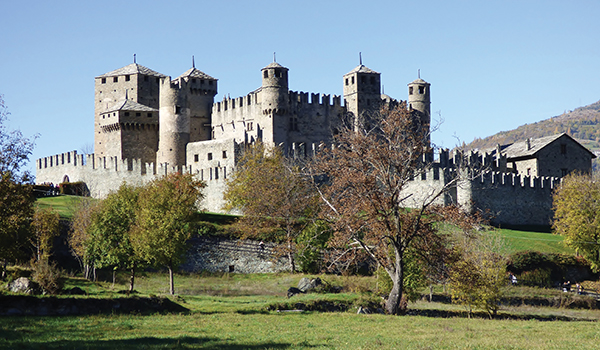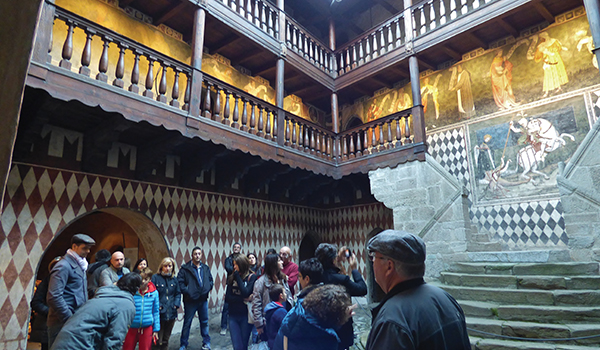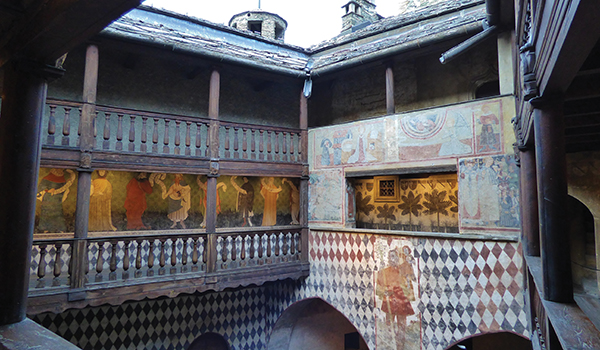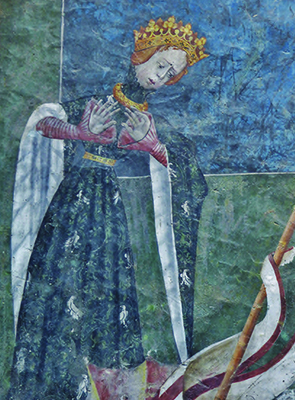When St George slayed the dragon and rescued the princess, he acted with fearlessness – but his brave horse was never quite so sure that the fight would be won.
High in the Alps, in the far northwest of Italy, is the Valle d’Aosta, the smallest of Italy’s official regions, and the most lightly populated. On its northern margin, Monte Bianco (Mont Blanc) stands like a giant watchtower looking north and west into France, while Monte Cervino (the Matterhorn) is on duty where Italy meets Switzerland. To the southeast is Piedmont.
The area’s principal city is Aosta, built by the Romans in 24 BC to house retired legionnaires; the town’s name is a time-altered version of Augustus. Ancient city walls, bridges, towers, and gates still survive, almost intact. The tall façade of a Roman theatre looms over its auditorium, and just on the edge of the old town is a triumphal arch dedicated to Augustus.
Many people visit the Valle d’Aosta to ski, hike, or soak in the thermal spas at Pré Saint Didier and Saint-Vincent. We came to visit castles. There’s something soul-satisfying about stepping back in time in a stately old castle.
Valle d’Aosta’s area and population may be small, but there are castles aplenty here – ruined castles, rebuilt castles, picturesque castles, austere castles and luxurious castles. Various sources place the number of castles, forts, towers and the like in the Valle d’Aosta at around one hundred. Most are from medieval times, when powerful families collected tolls on the Alpine trade routes and built strongholds to guard their territory, though one of the prettiest castles, Castello Savoia, was built for Queen Margherita of Savoy in 1904 as a mountain getaway.
The House of Savoy ruled the area (with some interruptions) from the 11th century until Italian unification in 1870, and granted fiefdoms to favoured noble families; and every noble family had to have a castle or two, of course. One of the most important – and prolific – of these families was the Challant clan.
In the late Middle Ages, you could hardly swing your broadsword without hitting a Challant family castle. There is Issogne Castle, for example, which Yblet de Challant took away from the Bishop of Aosta in 1379; and less than two miles away, across the Dora Baltea River, is Castle Verrès, which the Counts of Savoy had given to the Challants a couple of years before.
I could go on, but I’d rather tell you about Fénis Castle. It’s one of fifteen castles in the valley that the public can tour, and since it is just a few miles east of Aosta, on a pleasant green knoll with cowbells clanging in a nearby pasture, it’s a popular spot for family outings.

In such a peaceful spot the castle’s appearance is especially striking: a double line of defensive walls, bristling with swallowtail crenellation, surrounds the castle-keep, battlements, parapets, corbelled towers with archers’ loopholes, and a residential block defended by a portcullis. It seems to be prepared for an imminent siege, though I can’t find any record that the castle was ever attacked – and it’s been perched on its little hill since before the Counts of Savoy gave it to Gotofredo of Challant in 1242.
Of course there have been many modifications and additions since then; the castle’s present shape dates from the time of Aimone of Challant around 1340, except for the outer walls, which were added in the 1930s! But the real glory of Fénis Castle is due to Aimone’s son, Bonifacio I, who, in 1393, began remodelling the residential areas. He got the fireplaces drawing again, stopped the drafts from the doors and windows, and furnished the courtyard with a graceful semi-circular staircase leading to an elegant double loggiato around the courtyard interior.
And then he had a brilliant notion: he hired the artist Giacomo Jaquerio to fresco the staircase landing, the walls of the loggiato, and the family chapel.
The paintings are superb, colourful examples of the late Gothic style, and brighten the otherwise dark, sombre courtyard. In the chapel, under a dramatic wooden crucifix, the Madonna della Misericordia shelters Bonifacio’s family under her cloak, while Archangel Michael, John the Baptist, and St Peter look on approvingly. Around the loggiato painted prophets wave scrolls bearing proverbs in Old French, almost as if they are cheering for St George against the dragon (frescoed on the staircase landing).


And it is the St George fresco that I will chiefly remember from my visit to Fénis Castle.
The saint, of course, has saved the sacrificial princess by spearing the dragon. She views the whole scene with refined distaste. St George glares with superhuman courage at the still writhing monster. But someone else is looking on, too. The saint’s horse, a rearing white steed, also stares at the dragon; but unlike his fearless rider, he looks distinctly uneasy. The artist has painted, for Bonifacio of Challant, and for us 600 years later, a subtle visual joke: a friendly wink from long ago.

About the writer:
Joe writes about travel, history and culture, and divides his time between the southwest US and Europe. Learn more at www.joegartman.com.
